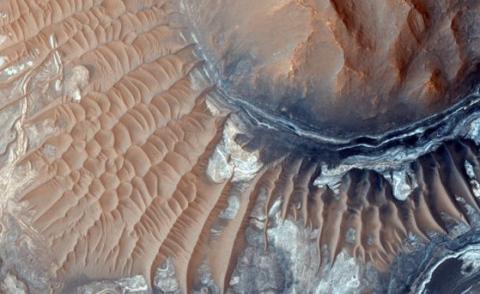A New Look at Ancient Mars
Yet the actual story of Mars is weirder, grander, and in some ways more terrifying than any of the fictions that humans have spun. Although the planet has a diameter about six-tenths that of Earth and weighs in at only eleven per cent of Earth’s mass, it is in other ways a place of extremes. Its entire top seems to have been blown off in an early impact, resulting in a so-called crustal dichotomy: Mars’s northern hemisphere is at an average elevation one and a half miles lower than the southern. The planet is scarred by a vast chasm, the Valles Marineris, which is five times longer and two and a half times deeper than the Grand Canyon. Superimposed on the continental United States, it would stretch from the Carolinas to California.
Diminutive Mars is also home to the solar system’s most gargantuan volcano, Olympus Mons. It has a footprint the size of Arizona and a height almost three times that of the Earth’s largest volcano, Mauna Loa. Other than an unexplained near-vertical four-mile-high scarp around its base, Olympus Mons has the gentle slopes that are typical of terrestrial shield volcanoes, like those in Hawaii, which are built of basalt. But Olympus Mons is just one of many overgrown volcanoes on a high lava plain called the Tharsis Bulge. The eruptions that formed the Tharsis Bulge, driven by convective overturn in the Martian mantle, transferred so much mass from the interior to the exterior of Mars that at some point the volcanic carbuncle was large enough to alter the planet’s rotation. The huge pile of basalt, formed initially at high latitude, caused Mars to tip over on its side, even as it continued rotating on the same axis with respect to its path through space. Areas that once were close to the poles now lie near the equator—as if northern Greenland became the new Bahamas—a phenomenon known as true polar wander.
The growth of the Tharsis Bulge and the resultant listing of the planet were previously thought to have happened very early in Mars’s development, more than three and a half billion years ago, during the Noachian Era. (Because Mars has a very different geologic—or, to purists, areologic—history than Earth, it does not make sense to use the Earth-based geologic timescale, whose divisions correspond to important chapters in our planet’s evolution.) The use of the name “Noachian” for a Martian time period may seem rather ironic, given the strenuous efforts of geologists to distance their discipline from biblical floods, but it is clear from fossilized drainage networks on the Martian surface that Mars once did have abundant running water. The distribution of these ancient river systems should reflect both latitudinal variations in precipitation and the regional slopes created by the Tharsis Bulge, if it indeed existed at the time the rivers flowed.
A new study in this week’s issue of Nature, by the geoscientist Sylvain Bouley and six of his colleagues in France, Senegal, and the United States, suggests that some of this history may need to be rewritten. The authors argue that the Tharsis-induced planetary toppling occurred well after the Noachian, and that the decline of an active water cycle on the planet coincided with the end of vigorous volcanism. When they restored Mars to its pre-polar-wander position, and also removed the flattening related to its spin on its present-day axis, they found that the ancient valley networks define a band of streams that flowed from the southern hemisphere toward the northern lowlands. This is consistent with precipitation patterns predicted by climate models of a Mars without the Tharsis Bulge, on which the crustal dichotomy dictated drainage patterns. Percival Lowell was right about Martian water transfer, but he had the directions, dates, and responsible parties all wrong.
The new study’s conclusions are satisfying in that they suggest a coherent story of the gradual decline of Mars as an active planet. On rocky planets like Earth and Mars, volcanic emissions are the primary source of atmospheric gases, including water vapor. A body as small as Mars, with a weak gravitational pull, will quickly lose its atmosphere to space without constant volcanic replenishment. It makes sense, then, that the valley networks on Mars—records of halcyon days when there were rains and rivers—would have taken shape while the great Tharsis volcanoes were in their formative stages. By the time the volcanoes got large enough to affect the planet’s rotation, they were on their way to dormancy. The planet had cooled, the interior ceased convecting, and the great volcanoes exhaled their last breaths. Martian waters slowly dissipated to space, and the disfiguring Tharsis lump pulled the dying planet over, carrying the abandoned river valleys to foreign latitudes.
There is pathos in the story of a planet that would seem to have had the promise of a much longer biography. In contrast to Earth’s geologic timescale, whose divisions get finer as we approach the present day, the past three billion years on Mars, during which little has changed, are considered one long era (the Amazonian, another ironic choice of names). Earth, meanwhile, had the advantage of its greater size and gravity, but it also struck fortuitously upon a marvellous system for recycling and sequestering water and other atmospheric gases for later use—namely, plate tectonics, which, via the subduction of ocean crust, keeps the interior and exterior of our planet connected in a way that Mars never had time to try.
The stories that humans have long told about Mars—most of them narcissistically anthropocentric—have all missed the point. The most important message from Mars may be what it is telling us about how it parted ways long ago with an even stranger planet known as Earth.
Marcia Bjornerud

